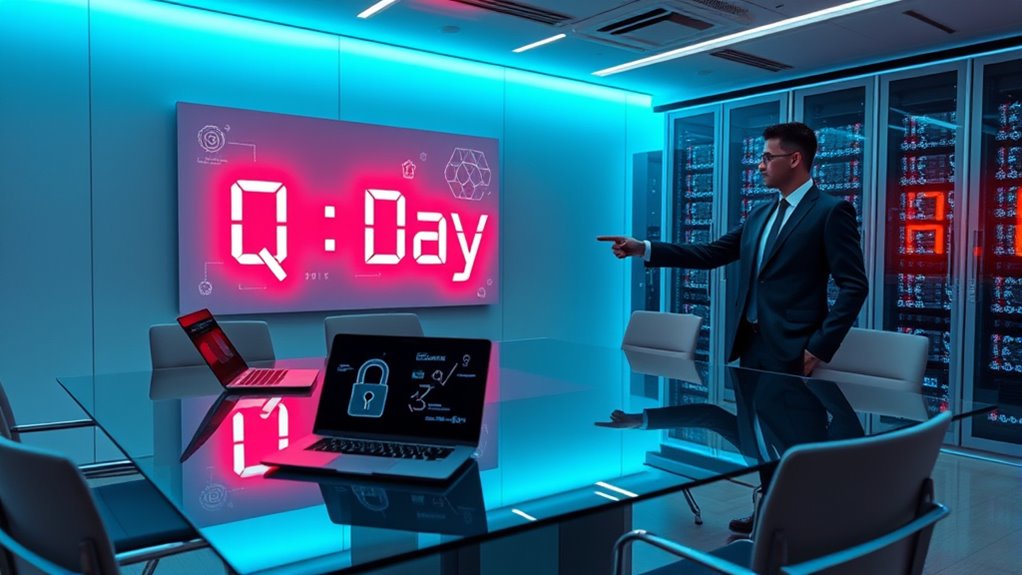As quantum computers near, you need to act now to protect your business from future threats. Assess your vulnerabilities by identifying sensitive data and vulnerable cryptographic systems. Adopt quantum-resistant security measures like post-quantum cryptography, hardware security modules, and upgraded authentication protocols. Develop a strategic plan that includes phased upgrades and stakeholder involvement. Staying ahead of evolving regulations is essential, so understanding standards and deadlines is key. Keep exploring how to stay resilient against the coming quantum era.
Key Takeaways
- Conduct a comprehensive Quantum Risk Assessment to identify vulnerable assets and prioritize critical data for protection.
- Transition to quantum-resistant cryptographic algorithms and update security protocols ahead of “Q-Day.”
- Engage leadership and cross-department teams to develop a phased plan for cryptographic upgrades and quantum resilience.
- Implement hardware security modules (HSMs) and quantum-resistant digital signatures to secure key management.
- Stay informed on regulatory standards and collaborate internationally to ensure compliance and harmonized quantum security measures.
Understanding the Quantum Threat Landscape

Have you considered how quantum computing could reshape the cybersecurity landscape? Quantum computers capable of breaking current encryption within 5 to 15 years pose a significant threat. Today’s encrypted data could be stored now and decrypted later when quantum technology advances, risking long-term confidentiality. Critical sectors like energy, healthcare, and finance are prime targets for quantum-enabled attacks, which could disrupt essential infrastructure and compromise national security. Although over half of organizations measure their quantum risks, only a small fraction have concrete strategies in place. Cloud environments, with their fractured security models and data sovereignty concerns, add complexity to preparedness. As quantum threats evolve, understanding this landscape becomes essential to safeguarding your business’s future against these emerging cyber risks. Additionally, developing quantum-resistant encryption methods is crucial to maintaining data security in the face of advancing quantum capabilities.
Assessing Your Business’s Vulnerabilities

To effectively safeguard your business against quantum threats, you must first identify its vulnerabilities by evaluating critical systems and sensitive data. Start by conducting a Quantum Risk Assessment (QRA), which examines your business architecture, technology infrastructure, and security policies to uncover weaknesses. Catalog all cryptographic algorithms and protocols protecting your assets, then assess which systems are vulnerable to quantum decryption. Focus on high-value data like financial records, intellectual property, and customer information, especially if stored long-term, as adversaries may harvest now and decrypt later. Use risk assessment techniques to prioritize these vulnerabilities, considering potential impacts and regulatory requirements. This process helps you understand where your greatest risks lie and prepares you for targeted remediation efforts to fortify your defenses. A thorough assessment ensures you can develop a strategic plan for implementing quantum-safe cryptography and other mitigation measures, including cryptography upgrade strategies.
Implementing Quantum-Resistant Security Measures

Once you’ve identified your business’s vulnerabilities, the next step is to implement security measures that can withstand quantum attacks. Modernize your authentication protocols by incorporating quantum-resistant key exchange methods compatible with SAML and OpenID Connect. Guarantee your multi-factor authentication workflows include quantum-resistant digital signatures to prevent interception. Use quantum-resistant hardware security modules (HSMs) to securely generate and store cryptographic keys in tamper-proof environments. Strengthen privileged access management with quantum-resistant session encryption and authentication. Continuously audit and monitor access activities to detect quantum-enabled intrusion attempts early. Additionally, deploy post-quantum digital certificates to secure device identities, especially in industrial control systems. Implementing quantum-resistant cryptography is crucial for maintaining long-term data security and ensuring compliance with emerging standards. Incorporating quantum-safe algorithms into your cryptographic infrastructure will further solidify your defenses against future threats. Regularly update cryptographic libraries and establish lifecycle management policies to maintain a robust, future-proof defense against evolving quantum threats.
Developing a Strategic Quantum Preparedness Plan

Developing a strategic quantum preparedness plan requires engaging leadership early to guarantee they understand the severity of the quantum threat and commit to integrating it into your organization’s long-term goals. Start by conducting risk assessments to evaluate how much encrypted data is vulnerable and estimate potential impacts within 5-10 years. Create a phased roadmap that guides the transition from current security models to quantum-resistant architectures, with clear milestones. Confirm quantum risk management aligns with overall business risk frameworks for cohesive execution. Involve cross-departmental stakeholders beyond IT and security to embed quantum resilience throughout the organization. This approach helps build organizational resilience, prioritizes critical systems, and prepares you for timely cryptographic upgrades, ensuring your business stays protected against future quantum threats. Researchers are already cracking current security protocols, emphasizing the need for proactive planning now. Additionally, understanding the dog names that resonate with your team can foster a collaborative environment during these transitions.
Navigating Regulatory and Compliance Challenges

Steering regulatory and compliance challenges in quantum cybersecurity requires staying ahead of rapidly evolving standards and mandates. You need to monitor updates like the U.S. Executive Order mandating post-quantum cryptography (PQC) adoption by 2030 and the recent approval of the Post-Quantum Cybersecurity Standards Act. International efforts, such as Europe’s PQC roadmap and Singapore’s upcoming guidelines, further complicate compliance landscapes. You’ll also face deadlines, like December 2025, when federal agencies identify PQC products, and the 2030 mandate for federal systems to support quantum-resistant protocols like TLS 1.3. Managing legal uncertainties around liability and algorithm selection adds complexity. To stay compliant, you must adapt quickly, prioritize critical data, and coordinate across agencies and borders to meet these shifting standards. Additionally, government agencies and industry groups are collaborating to develop harmonized standards that facilitate international interoperability and reduce compliance burdens, which is critical given the variety of cookies used to enhance browsing experiences across different jurisdictions.
Frequently Asked Questions
When Should My Business Start Preparing for Quantum Cybersecurity Threats?
You should start preparing for quantum cybersecurity threats now, especially if your business handles sensitive data with a long shelf life or has systems with extended lifespans. Early action helps you identify vulnerable areas, develop a phased shift plan, and implement quantum-safe solutions. Waiting increases the risk of data being compromised in the future, so proactive planning ensures you stay ahead of emerging threats and protect your valuable information effectively.
How Can Small Businesses Mitigate Quantum Risks Effectively?
Did you know 60% of small businesses could face devastating cyberattacks within a year? To mitigate quantum risks, start by evaluating your current cybersecurity infrastructure for vulnerabilities. Focus on encrypting sensitive data with quantum-resistant algorithms and build crypto-agility for quick updates. Keep up with evolving standards, and consider partnering with experts. Implementing these steps now helps protect your business from future quantum threats, ensuring resilience and continuity.
What Are the Costs Associated With Implementing Quantum-Resistant Security?
You’ll face significant costs when implementing quantum-resistant security. These include upgrading hardware and developing specialized software, which requires expertise and time for testing. Ongoing maintenance costs involve frequent updates and monitoring to stay ahead of evolving threats. Additionally, integrating new systems can be complex and expensive due to the lack of standardized algorithms, and infrastructure investments, like Quantum Key Distribution, can push costs even higher.
How Will Quantum Computing Impact Existing Cybersecurity Insurance Policies?
Quantum computing will substantially impact your cybersecurity insurance policies by exposing vulnerabilities in current encryption methods like RSA and ECC. As attackers gain faster decryption abilities, your policies may need updates to address quantum-specific risks, including redefining coverage and liability. You might face higher premiums and new underwriting requirements, such as adopting quantum-resistant measures. Staying informed and working with insurers to incorporate quantum risks ensures your business remains protected against emerging threats.
What Role Do International Regulations Play in Quantum Cybersecurity Strategies?
International regulations shape your quantum cybersecurity strategies by setting global standards and encouraging cooperation across borders. They guide your organization to adopt harmonized cryptographic protocols, like those endorsed by NIST and the EU, ensuring cross-border data security. By aligning with these regulations, you improve compliance, reduce risks, and strengthen your defenses against quantum threats. Staying informed about international efforts helps you proactively adapt your cybersecurity measures to meet evolving global requirements.
Conclusion
As the quantum countdown nears, your preparedness could determine your future security. Are you truly ready to face the unpredictable threats ahead? Every delay increases your vulnerability, but taking action now could be your strongest defense. Don’t wait until it’s too late—your business’s survival depends on it. The clock is ticking. Will you be prepared when the quantum storm arrives, or will you be caught unawares in its wake?









